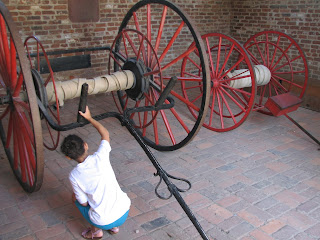On Oct. 16, 1859, John Brown led a group of 21 abolitionists on a raid of the Harpers Ferry Arsenal in hopes of using the weapons to arm a Slave revolt in the South. When news of the raid reached nearby Charles Town, the local militia pinned down Brown's forces inside the engine house which was adjacent to the armory. A force of 86 marines was sent up from Washington DC under the command of Army Lieutenant Colonel Robert E. Lee (assigned as impromptu commander while on leave). When negotiations failed, they stormed "John Brown's Fort" and captured most of the raiders. John Brown was tried for treason, convicted and hung in Charles Town. The incident, which stirred up bitter feelings in both the North and the South, served as one of the catalysts of the Civil War.
During the Civil War, possession of Harpers Ferry changed 8 times, suffering critical damage each time forces plunged through the area invading enemy territory. The most extensive damage to the town occurred during the Battle of Harpers Ferry which was fought between Sept. 13-15, 1862. It ended with the surrender of 12,419 Federal troops - the largest single surrender of U.S. troops until the Battle of Bataan during WWII. Following the war, the U.S. government decided not to rebuild the armory, causing the town to lose much of its importance as a linchpin between the North and South.
 |
| Civil War relics |
Cost: $10/vehicle (excludes groups of 7+); $5/person (on foot or bicycle)
Time: The Park is open from 9 am - 5 pm daily; unless you are there for one of the special events, you will probably spend about 1-3 hours here.
Description: John Brown's Fort was erected in 1848 as the Armory's fire engine and guard house. John Brown and his followers barricaded themselves in this building during their 1859 raid of the Armory. During the Civil War, the building served various functions as a prison, a powder magazine, and a quartermaster's supply house. It was dismantled and shipped to Chicago for the World's Colombian Exposition before being shipped back several years later, but rebuilt on a different site. It was purchased by Storer College, which used it as a museum. Eventually, it was purchased by the NPS and moved rebuilt 150 east of its original location (which is covered by a railroad embankment).
 |
| John Brown's Fort |
The Lockwood House was originally constructed as the home of the Armory Paymaster in 1848. During the Civil War it was used as a hospital, and then as the headquarters of Brig. General Henry Lockwood as well as Major General Philip Sheridan. It served other purposes as well - a bivouac, a prison, and even a ballroom (Thanksgiving 1863). After the war, it was used as a school for former slaves, and eventually became the nucleus of Storer College.
Loudoun Heights are located on the second highest mountain at Harpers Ferry. In 1861, Col. Thomas Jackson ordered three infantry blockhouses built on the summit. During the Battle of Harpers Ferry (Sept. 1862), the Confederates were able to bombard the Union troops from atop the Heights while avoiding return fire.
Maryland Heights are located on the highest mountain at Harpers Ferry. They hosted the first battle between Union and Confederate troops in Maryland. It was also the key target of southern troops in the Battle of Harpers Ferry. When Union troops were obliged to abandon its summit, the southerners were able to cut off the Union's escape route and secure the surrender of the U.S. garrison on Sept. 15. Having learned the importance of retaining the high ground the hard way, the Union later built forts on top of the mountain that played a major role in forestalling the Confederacy's third invasion of the north.
Jefferson's Rock is located along the Appalachian Trail between Lower Town and Camp Hill. From this spot, Thomas Jefferson, traveling to Philadelphia, is said to have gazed upon the valley and declared it "perhaps one of the most stupendous scenes in nature." Visitors are not allowed to climb on the rock itself since it is unstable and is protected as a cultural resource.
The Point refers to the confluence of the Potomac and Shenandoah rivers, which also forms the dividing lines between the three states. This was the site of the Ferry Lot Reservation which became a bustling commercial area for the growing town of Harpers Ferry. It's location became even more prosperous with the completion of the famous B&O Railroad viaduct across the Potomac River. During the Civil War, however, the bridge was blown up by Confederate troops, and the buildings were burned down by Union troops. During the war, the bridge was rebuilt and destroyed nine times before the completion of the Bollman Bridge in 1870. This bridge eventually fell victim to the great flood of 1936.
 |
| Remains of destroyed bridge |
Things You Should Know: - I strongly recommend visiting during one of the many special events that occur throughout the year since it will enhance your visit. Below are links to several of the various events that will occur throughout the year.
- Harpers Ferry hosts several different Living History Event Weekends throughout the year. Visit the National Park's website calendar for specific dates.
- 2017 marks the 150th anniversary of Storer College. To see the special events marking this anniversary, click here.
- To participate in Cultural Resources Programs throughout the year, click here.
- Harpers Ferry has a variety of hikes you can take. For details, click here.
- Historic trades workshops are given on select dates.
- Harpers Ferry was a supply stop by Lewis & Clark on their famous expedition of 1803.
Nearby: Gathland State Park, Catoctin Creek Park and Nature Center, South Mountain State Park, Washington D.C.







No comments:
Post a Comment